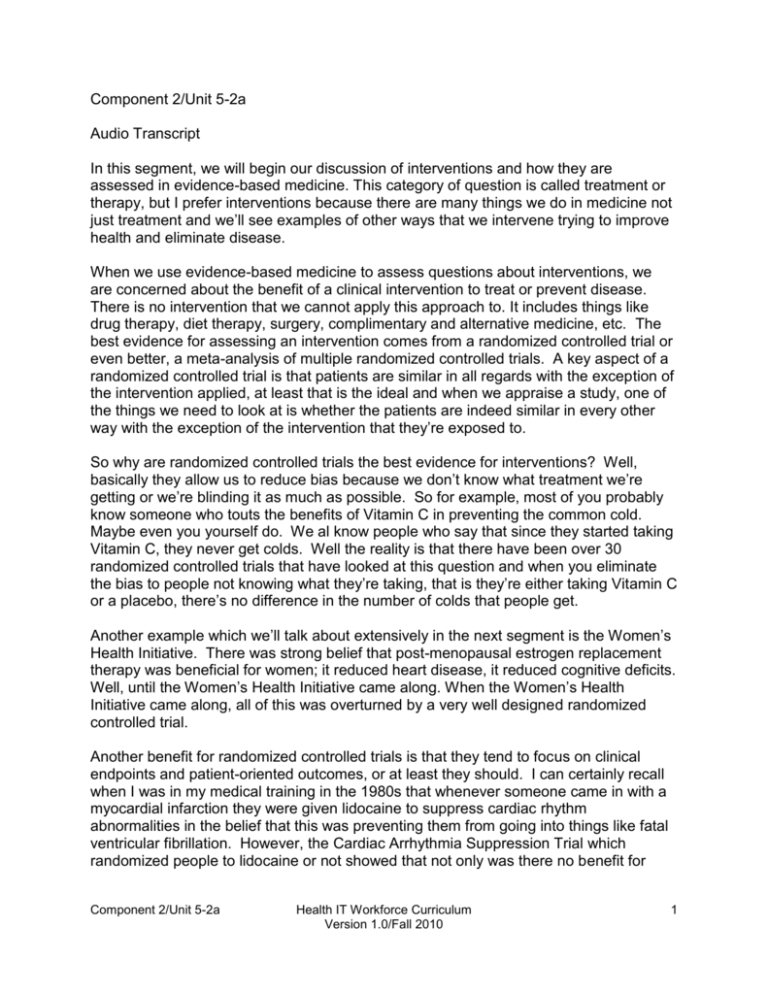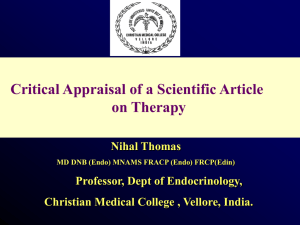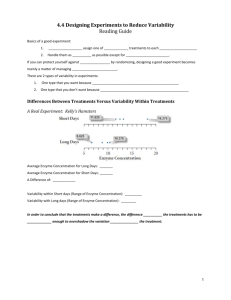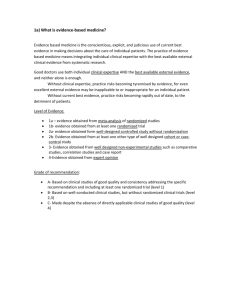comp2_unit5_2a_audio_transcript
advertisement

Component 2/Unit 5-2a Audio Transcript In this segment, we will begin our discussion of interventions and how they are assessed in evidence-based medicine. This category of question is called treatment or therapy, but I prefer interventions because there are many things we do in medicine not just treatment and we’ll see examples of other ways that we intervene trying to improve health and eliminate disease. When we use evidence-based medicine to assess questions about interventions, we are concerned about the benefit of a clinical intervention to treat or prevent disease. There is no intervention that we cannot apply this approach to. It includes things like drug therapy, diet therapy, surgery, complimentary and alternative medicine, etc. The best evidence for assessing an intervention comes from a randomized controlled trial or even better, a meta-analysis of multiple randomized controlled trials. A key aspect of a randomized controlled trial is that patients are similar in all regards with the exception of the intervention applied, at least that is the ideal and when we appraise a study, one of the things we need to look at is whether the patients are indeed similar in every other way with the exception of the intervention that they’re exposed to. So why are randomized controlled trials the best evidence for interventions? Well, basically they allow us to reduce bias because we don’t know what treatment we’re getting or we’re blinding it as much as possible. So for example, most of you probably know someone who touts the benefits of Vitamin C in preventing the common cold. Maybe even you yourself do. We al know people who say that since they started taking Vitamin C, they never get colds. Well the reality is that there have been over 30 randomized controlled trials that have looked at this question and when you eliminate the bias to people not knowing what they’re taking, that is they’re either taking Vitamin C or a placebo, there’s no difference in the number of colds that people get. Another example which we’ll talk about extensively in the next segment is the Women’s Health Initiative. There was strong belief that post-menopausal estrogen replacement therapy was beneficial for women; it reduced heart disease, it reduced cognitive deficits. Well, until the Women’s Health Initiative came along. When the Women’s Health Initiative came along, all of this was overturned by a very well designed randomized controlled trial. Another benefit for randomized controlled trials is that they tend to focus on clinical endpoints and patient-oriented outcomes, or at least they should. I can certainly recall when I was in my medical training in the 1980s that whenever someone came in with a myocardial infarction they were given lidocaine to suppress cardiac rhythm abnormalities in the belief that this was preventing them from going into things like fatal ventricular fibrillation. However, the Cardiac Arrhythmia Suppression Trial which randomized people to lidocaine or not showed that not only was there no benefit for Component 2/Unit 5-2a Health IT Workforce Curriculum Version 1.0/Fall 2010 1 lidocaine, but it was actually dangerous and the practice quickly stopped. We also tend to have this view that anything new is better. One researcher looked at radiation oncology trials and noticed that new treatments were just as likely as not to be successful. So just because we introduced something new, doesn’t mean we cannot test it out, we have to do so in a randomized controlled trial to demonstrate it being better. There have been other interesting findings about randomized controlled trials discovered over the years. One is that there seems to be this inverse relationship between the quality of the study and the magnitude of the treatment effect. That is, in general, everything else being equal the better design the study, the lower the treatment effect – the lower the benefit of the treatment and we’ll see how that’s actually measured in a moment. It’s also been found that evidence of lower quality, particularly non-randomized controlled trials is more likely to be later overturned than good high quality evidence. However, it should be noted that well-designed observational studies where you don’t randomize and control people, may be just as good but the observational studies do need to be well designed and well carried out. There’s a fascinating history of randomized controlled trials, I’ll just mention a few highlights here. It’s often been said that the first randomized controlled trial was performed by Dr. James Lind, who was a British naval doctor and surgeon in the 1700s. He, for whatever reason, performed experiments where he gave and didn’t give citrus fruits, in particular lemons and oranges, to sailors and he noticed unequivocally that the sailors who administered citrus fruits to did not develop scurvy which of course is due to Vitamin C deficiency and those who did not get the citrus fruits were much more likely to develop it. The first true randomized controlled trial was performed in the UK in the 1940s. It was a trial that looked at the treatment of tuberculosis and it compared streptomycin an early antibiotic for tuberculosis with placebo and demonstrated clear superiority for the antibiotic. So how do we critically appraise a study about an intervention? Well remember from the last segment, there were three questions that we ask of any study: Are the results of the study valid? What do the results show? Can the results be applied to patient care? Or the last question if you’re actually a clinician taking care of a patient, can the results be applied to my patient here that I’m making this decision on? Let us look in more detail at the question of the results being valid. So we ask, did the experimental and control groups begin the study with a similar prognosis? That is, were the patient groups identical? Were the patients then randomized into the control or experimental treatment? Was the randomization concealed from the clinician, that is did the clinician have absolutely no role in the randomization, because if the clinician can bias the randomization, then they will bias the trial. Were the patients analyzed in the groups to which they were randomized, this is sometimes called intent to treat analysis. Because we’re looking at a question at a point in time, we have to analyze patients in the groups to which they were randomized because that’s the decision that Component 2/Unit 5-2a Health IT Workforce Curriculum Version 1.0/Fall 2010 2 we’re trying to evaluate in this randomized controlled trial. Then, were the patients in the treatment and control groups similar with respect to the known prognosis? Sometimes the randomization doesn’t work and we end up with somewhat different groups and that causes us to have concerns about the validity of the randomized controlled trial. There are more questions to ask about the validity of the results. In particular, did the experimental control groups retain a similar prognosis after the study started? Were the patients aware of what group they were allocated into, were the clinicians aware, or were the assessors the people judging the output of the study. Now some studies the patients know what group they are allocated into for example, if it’s a study about surgery and the clinicians obviously know as well. But you want to make sure that the randomization process works and that the assessors to the extent possible are not aware of the group allocation. We also need to know that the followup was complete, that a large proportion of patients were not lost to followup. Once we are confident that the study is valid, we can then proceed to look at the results. There are two major issues we deal with with the results that are how large was the treatment effect or how beneficial was it if it is indeed beneficial, and then how precise was the estimate of treatment effect. We’ll explore each of these in the following slides but with the treatment effect, we ask about both the relative risk reduction and the absolute risk reduction. It’s important to understand the difference between the two of these and we may be swayed by one or the other but we need to know both the relative risk between the different treatments or the treatment and placebo. We also need to have the larger perspective of the absolute risk reduction to know how much impact we’re having on the population of people that we’re treating. For the precision of the treatment effect, we basically need to know whether it is statistically significant, so we need to know the confidence in our roles or the p values for the experiments. Once we know the treatment effect, we can then ask if the results can be applied to patient care. So, were the study patients similar to my patient? If they weren’t, then there might be some issues about the generalizability of the result. Were all the clinically important outcomes considered, even though there is always a primary outcome in a study, did they look at other outcomes so we can assess the larger perspective of the benefit of the intervention. And then, are the likely treatment benefits worth the potential harm and costs. We’ll see that randomized controlled trials don’t always do a good job of accounting for adverse effects, but we must analyze the reports of adverse effects so we can balance the benefits and the harms. So how do we ascertain the treatment effect? There is a little bit of mathematics here, but it’s really not that complicated. We basically need to think about events and interventions. So, an event is at least in the usual context of evidence-based medicine statistics, something that’s bad. An event is a death, it’s the development of some symptoms, and it’s some recurrence of cancer. The intervention then has a control which might be a placebo or it might be the known current best effective treatment and Component 2/Unit 5-2a Health IT Workforce Curriculum Version 1.0/Fall 2010 3 then we have an experimental intervention that is what we’re testing against the control. In order for us to use these statistics, there has to be the existence of statistical significance. If statistical significance doesn’t exist then these numbers are meaningless. That’s important to recognize this up front. Once we have determined the number of control patients who had the event and did not have the event so that we have the total, and the experimental patients who had the event and did not have the event and their total, we can calculate these statistics. First there is the control event rate or CER, that’s the risk of the event from the control intervention. There is then the experiment rate or EER, that’s the risk of the event from the experimental intervention. We next calculate the relative risk of the experimental intervention so that’s EER divided by CER. Sometimes you’ll see the hazard ratio reported. The hazard ratio is not quite the same as the relative risk, but it has roughly the same meaning. It comes from survival analysis and factors in the time element of the experiment. When we know the relative risk, we can then calculate the relative risk reduction which is 1 minus the relative risk. That tells us how much reduction in relative risk the experimental intervention has relative to the control intervention. The absolute risk reduction tells us what difference there is in the overall event control rate minus the experimental event rate. With the absolute risk reduction, we can then calculate the number needed to treat which is one over the absolute risk reduction and that tells us how many patients we have to treat in order for one patient to have benefit. In addition to knowing the magnitude of the treatment effect, we want to know the precision of the estimate of the treatment effect. Remember that whenever we do a randomized controlled trial we’re doing it on a sample that will hopefully ask a question about an entire population. You can’t, for example, do a randomized controlled trial on everyone who has a given disease, especially highly prevalent diseases such as diabetes and hypertension. So we have to take a sample for which the results will hopefully apply to the population. When we do the study, we do the calculations and we get a point estimate whether it’s relative risk reduction or number needed to treat and the true result for the entire population can vary either due to chance which is what we’re concerned about here or bias if the study is actually not performed properly and we’ve addressed that issue in some of the previous slides. We want to know the possible range of results and we do this by calculating the confidence in our role. That gives us the range of values that includes the true value for the population 95% of the time. The larger the confidence interval, the less confident we are about whether the estimate from the study is actually precise. In the remainder of this segment and the beginning of the following one, we will look at some critical appraisals of some medical interventions. Some of these are very common problems, some of them are controversial, and all of them highlight the issues in trying to apply evidence-based medicine. We’ll look at low molecular weight heparin, a blood thinner vs. graduated compression stockings for preventing deep venous thrombosis in patients who have had arthroscopic surgery of the knee. We’ll look at eradication of the bacteria h pylori for reducing the recurrence of gastric cancer. We’ll look at a big topic that gets a lot of press; the primary prevention of coronary heart Component 2/Unit 5-2a Health IT Workforce Curriculum Version 1.0/Fall 2010 4 disease with statin drugs. We’ll look at, as I mentioned earlier, the Women’s Health Initiative that assessed hormone replacement therapy in post-menopausal women and in some ways is a poster child for evidence-based medicine. We’ll look at how tight control of diabetes mellitus may or may not prevent complications. Finally, we’ll look at screening to reduce mortality from prostate cancer. Let’s look at the study comparing low molecular weight heparin with graduated compression stockings in patients who have had arthroscopic surgery of the knee. This study was a randomized controlled trial, the primary outcome, so the main outcome looked at was asymptomatic proximal deep venous thrombosis or any type of symptomatic deep venous thrombosis within seven days of surgery. Asymptomatic proximal deep venous thrombosis would be detected by some sort of scan. There were about 1300 patients, a little more than that randomized into the control and experimental groups for the compression stockings, 21 out of 660 patients developed a deep venous thrombosis, the primary outcome; whereas with the low molecular weight heparin group, 6 patients out of 657 developed deep venous thrombosis. As you can see, just from looking at the numbers, the low molecular weight heparin appears to be beneficial but let’s go through the calculations. The control event rate for the compression stockings is .032 or 3.2%, the experimental event rate is .009 or .9%. This gives us a relative risk remember which is the EER divided by CER of .28 and so we have a relative risk reduction of .72 or 72%. Our absolute risk reduction that is how much does the risk change from the control group to the experimental group is .023 or 2.3%. We have a pretty substantial relative risk reduction although in the context because deep venous thrombosis is so rare, our absolute risk reduction is relatively small. That absolute risk reduction converts into a number needed to treat 43, so 43 people need to be treated with low molecular weight heparin to prevent one case of deep venous thrombosis. Let’s look at the second study, which is eradication of the bacteria H pylori, which many of you know is one of the major causes of peptic ulcers. This study looked at whether they’re eradicating that bacteria would reduce the recurrence of metachronous gastric tumor. Metachronous meaning a tumor that redevelops in a different part of the organ, in this case the stomach. No eradication means that the patients were given a placebo and eradication means they were treated with a combination of Lansoprazole which reduces acid in the stomach as well as the antibiotics amoxicillin and Clarithromycin. Again, just looking at the numbers, you can tell that there was a much higher recurrence rate in the control group, 24 out of 272 compared to 9 out of 272 with the eradication group. That’s a control event rate of .088 and an experimental event rate of .033 that means the relative risk of eradication is .38 and the relative risk reduction is .62 or 62%. The absolute risk reduction is the control event rate minus the experimental event rate which is .055 so there’s a 5% absolute risk reduction which is higher than we saw in the previous slide with the low molecular weight heparin and here our number needed to treat is 18, so that is 18 people needed to be treated for H pylori to prevent one case of recurrent gastric cancer. Component 2/Unit 5-2a Health IT Workforce Curriculum Version 1.0/Fall 2010 5 Let’s look at a perhaps more controversial topic, which is the primary prevention of heart disease with statin drugs. In particular, probably the single best study in terms of study design as the ASCOT trial from Scandinavia, which was a randomized controlled trial giving individuals without preexisting heart disease, atorvastatin, or placebo. The primary outcome measure was either fatal coronary heart disease or a non-fatal myocardial infarction. This study was terminated early due to the quick development of a statistically significant from the atorvastatin although there were a number of people who disagreed with the decision to terminate so quickly as pointed out in letters to the editor in the journal in which it was published. So, again you can see that there appears to be some benefit for atorvastatin with the fewer number of primary outcome events. The control event rate was .030, experimental event rate .019, so this translates into a relative risk of .633 and a relative risk reduction of .367 or 36.7%. The controversy is that while this is an impressive relative risk reduction, the absolute risk reduction in all studies that have looked at statins and heart disease is much more modest. This is in part because the development of coronary events, in this case fatal coronary heart disease or non-fatal MI, is relatively infrequent in the very large population, especially the population of middle aged individuals for whom people wish to administer statins. The number needed to treat here is 1 divided by the absolute risk reduction .011 and that comes out to 91, so this means that 91 people need to be treated with Atorvastatin to prevent 1 case of the primary outcome. Given the small but significant side effects of statins, some people have concern that it might not be beneficial to treat such a large number of people. I should just add that clinical trials of people who already have heart disease, so secondary prevention keeping it from getting worse, have a much lower number needed to treat. The ASCOT trial looked at many other outcomes besides the primary outcomes which were the outcomes that were actually being studied explicitly and as you can see here, for other kinds of events like total cardiovascular events or total coronary events, the relative risk reduction is smaller, that is 20% in the case of total cardiovascular events and 28% in total coronary events, although the number needed to treat is a little smaller as well because the total number of these events is somewhat larger. This study maintains a very well developed website that presents these numbers and explains how the study was done and so forth. Another interesting finding in the study was that all-cause mortality was not statistically significant among the groups. So some have argued that well maybe you can reduce cardiovascular events and even cardiovascular deaths, but the overall mortality was not different between those who had Atorvastatin and those who had the placebo. This study and the other studies that have been done looking at this question of primary prevention of heart disease bring up some issues about evidence-based medicine that certainly apply to other common conditions but things we need to keep in mind. First of all, there have been many studies looking at primary prevention of heart disease, each slightly different with slightly different patient populations, and slightly different treatments. But ideally, we should look for a systematic review that brings all of these studies together even though they’re not quite homogeneous. What are some of the other major studies looking at primary prevention of heart disease? Well the first largescale study was the so-called west of Scotland study done is Scotland, showing roughly Component 2/Unit 5-2a Health IT Workforce Curriculum Version 1.0/Fall 2010 6 similar benefits to what the ASCOT trial showed. When patients who took part in both of these studies were looked at after the studies ended in the case of West of Scotland 10 years later and ASCOT 2 years later, there was still persisting benefit for the people who were randomized into the experimental group. There’s another study that got a lot of press, the ALLHAT- LLT study. This study caused a lot of controversy because it showed no benefit with treatment of statins although one of its criticisms was that the study had excess cross over, that is quite a number of people in the control group ended up being on statins. Another recent study was actually not a randomized controlled trial but an analysis of a registry so a retrospective cohort study in a large Israeli HMO and they looked at what they described as proportion of days covered for individuals by statins and those who were covered for more than 90% of the time had a 45% risk ratio of those who were not covered more than 90% of the time showing benefit for statins. All of these studies are the classic example of the relative risk reduction but a modest absolute risk reduction leading to a somewhat high number needed to treat. So, you need to give a lot of people the treatment to get the one patient who is going to benefit. How do you fit into all this if you’re middle-aged and wanting to decide whether you should take a statin for primary prevention of heart disease? Well, one thing you can do is calculate your own absolute risk. The best way to do that is to go to one of the many framing hand data calculators that’s available on the web and then you might be in a case like someone you know who’s a 50ish informatics professor, tries to live healthy, eats well, exercises, and has a low LDL, but also has a low HDL. Of course your own profile might be different, but I certainly scratch my head and wonder what is the right treatment for me. None of these treatments do I seem to fit in exactly and then that gets us back to the question of, do the results of these studies apply to my patient. Component 2/Unit 5-2a Health IT Workforce Curriculum Version 1.0/Fall 2010 7






